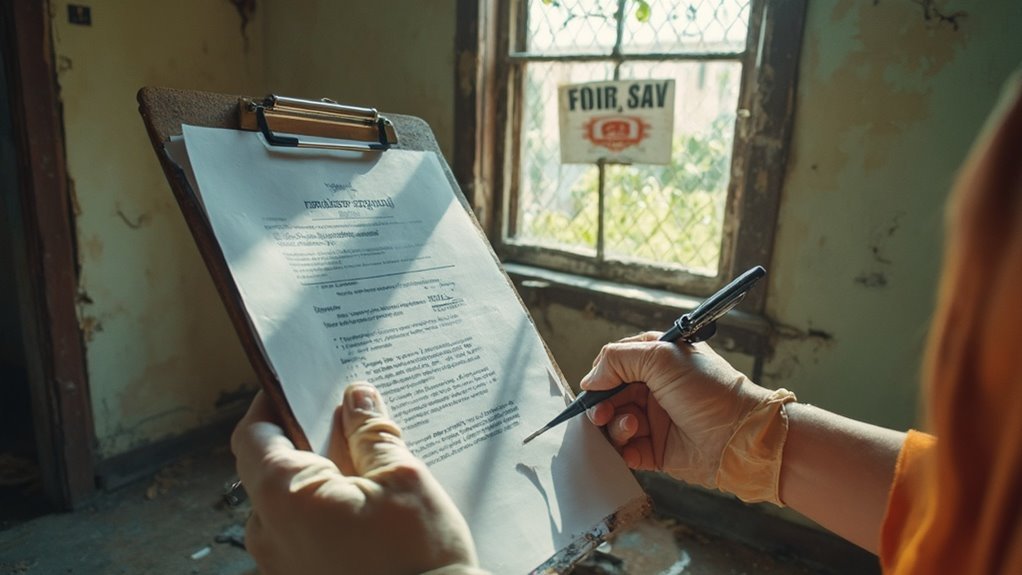An asbestos inspection can save you thousands in future repairs by uncovering hidden risks early. Identifying asbestos-containing materials allows you to act before they become costly health hazards or lead to structural damage. Early detection helps you avoid expensive medical bills and legal fees associated with asbestos exposure. Furthermore, properties without asbestos hold higher market value and are more appealing to potential buyers. Regular inspections additionally reduce insurance premiums and help you maintain compliance with safety regulations, avoiding fines. Understanding the full scope of your property's asbestos status can improve your decision-making process moving forward.
Importance of Early Detection

When it comes to asbestos exposure, catching potential health issues early can make all the difference. Regular asbestos screening is critical for individuals who've been exposed, whether through work or environmental factors. Early detection methods, such as chest X-rays and CT scans, are indispensable tools in lung monitoring, enabling healthcare providers to identify conditions like lung cancer and mesothelioma before they manifest symptoms. Asbestos fibers can disrupt cellular structures and lead to cancerous transformations over decades, underscoring the need for vigilance in monitoring health.
These diseases often develop silently, making it imperative to undergo periodic screenings. For instance, CT scans have shown effectiveness in detecting asymptomatic lung cancer in asbestos-exposed workers, yielding similar prevalence rates as those found in heavy smokers. This early detection can lead to a substantial reduction in mortality rates, highlighting the importance of proactive health measures.
Moreover, individuals exposed to asbestos should seek specialist care to navigate the complex terrain of potential misdiagnoses. As symptoms can mimic other less critical conditions, a knowledgeable expert will guarantee accurate diagnosis and tailored treatment plans. By prioritizing early detection through consistent screening and monitoring, you can markedly improve your chances of managing asbestos-related health risks effectively.
Financial Benefits of Inspections
Recognizing the importance of early detection in managing asbestos-related health risks naturally leads to an exploration of the financial benefits associated with regular asbestos inspections. By identifying and removing asbestos early, you can avoid costly health issues and reduce medical and legal expenses substantially. Addressing these issues before they escalate not only saves on future repair costs but also minimizes downtime and business interruption, ensuring your operations run smoothly.
Moreover, an asbestos-free property improves its value and marketability. Potential buyers or tenants are more likely to invest in a space that's compliant with safety regulations, providing peace of mind. This compliance plays a vital role in protecting you from costly fines and legal liabilities.
Additionally, regular inspections can lead to lower insurance premiums, reducing your overall costs. By proactively managing asbestos risks, you minimize the likelihood of disputes and litigation, which can be financially draining. In the long term, these financial savings contribute to increased stability and reputation, allowing you to focus on growth without the looming threat of asbestos-related complications. Prioritizing inspections is not just about safety; it's a wise financial decision.
Types of Asbestos Surveys

Understanding the different types of asbestos surveys is vital for managing asbestos risks effectively. There are primarily two survey types: Management Surveys and Refurbishment/Demolition Surveys.
Management Surveys are designed to identify asbestos-containing materials (ACMs) that might be disturbed during normal occupancy. They involve minor disturbances of ACMs to assess their condition and include sampling and analysis to confirm their presence. These surveys provide an initial guide for prioritizing the management of ACMs and are critical for fulfilling legal responsibilities under the Control of Asbestos Regulations 2012.
On the other hand, Refurbishment/Demolition Surveys are required before any major work. They involve a more intrusive assessment of ACMs in the specific areas where projects will occur, ensuring that all ACMs are located and described. Conducted by qualified professionals, these surveys are necessary for compliant and safe project execution.
Choosing the correct survey type depends on the nature of the work to be undertaken. Both types aim to identify and manage ACMs safely, but they have distinct methodologies and legal requirements that must be adhered to.
Regular Monitoring Advantages
Regular monitoring of asbestos not only safeguards health but also guarantees compliance with regulations. By conducting regular inspections, you guarantee adherence to both federal and local standards, effectively avoiding potential legal liabilities. This proactive approach not only prevents costly fines but also provides documented records that are crucial for future inspections and regulatory audits.
Implementing robust safety protocols through consistent monitoring substantially minimizes the risk of asbestos exposure for occupants and workers. Early detection of asbestos-containing materials allows for timely intervention, reducing the likelihood of serious health issues such as lung cancer or mesothelioma. Moreover, by addressing any potential hazards before they escalate, you can prevent extensive repairs and associated costs down the line.
Furthermore, regular monitoring allows you to make an informed decision about asbestos management, ultimately preserving the health and safety of everyone involved. The peace of mind that comes from knowing your building is compliant and safe cannot be overstated. In essence, by prioritizing regular asbestos inspections, you not only protect lives but also boost compliance benefits, guaranteeing a safer environment for all.
Impact on Property Value

The presence of asbestos in a property can substantially impact its market value, making it a critical concern for homeowners and potential buyers alike. Properties with identified asbestos often sell for 5-15% less than similar asbestos-free homes, which can lead to significant financial repercussions. The location and condition of the asbestos—whether in structural components or less critical areas—affect how much value is lost. Real estate appraisals will factor these elements in, resulting in market adjustments that reflect the risks associated with asbestos.
Asbestos disclosure is crucial in real estate transactions. If buyers uncover asbestos during inspections, they may demand price reductions or even walk away, complicating buyer negotiations. Legal implications additionally loom large, with potential liabilities for sellers who fail to disclose asbestos findings. To mitigate these issues, conducting a professional asbestos inspection and providing transparent documentation can build trust between parties and streamline negotiations. Furthermore, considering encapsulation as a cost-effective solution for asbestos management may help maintain property value. Ultimately, understanding and addressing asbestos-related concerns upfront can save you thousands in future repairs and improve your property's market appeal.
Frequently Asked Questions
How Long Does an Asbestos Inspection Typically Take?
An asbestos inspection typically takes a few hours to several days, depending on building size. After visual assessment, asbestos sampling occurs, followed by laboratory analysis, which usually takes 3 to 10 days for results.
Can I Conduct an Asbestos Inspection Myself?
Did you know that 70% of DIY asbestos tests return inaccurate results? Conducting an inspection yourself poses significant DIY risks and safety concerns, as improper handling could release hazardous fibers, jeopardizing your health and safety.
What Qualifications Should an Asbestos Inspector Have?
To be an asbestos inspector, you need accredited asbestos training and to meet specific certification requirements. This often includes relevant work experience, passing an exam, and ongoing education to maintain your certification.
How Often Should I Schedule Asbestos Inspections?
Did you know that over 60% of schools contain asbestos? You should schedule inspections every 6-12 months for regular monitoring. This preventive maintenance ensures safety and compliance, particularly in older or high-occupancy buildings.
What Happens if Asbestos Is Found During an Inspection?
If asbestos is found during an inspection, you'll need to arrange for asbestos removal by certified professionals. This process helps mitigate legal liabilities and guarantees compliance with safety regulations, protecting both health and property value.
